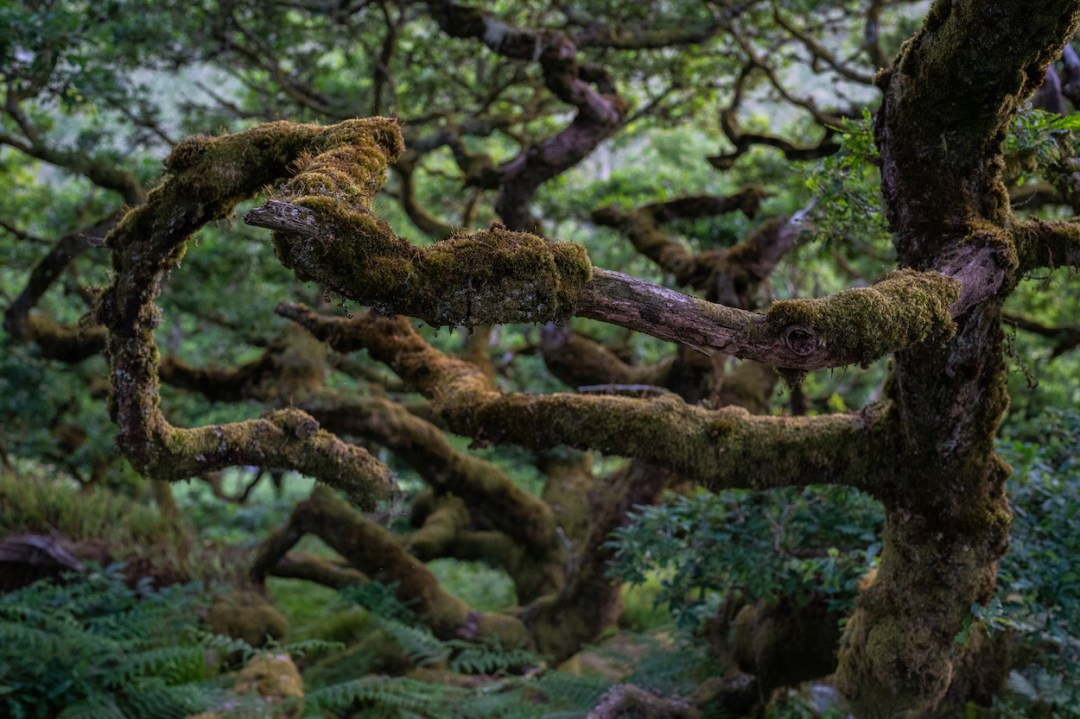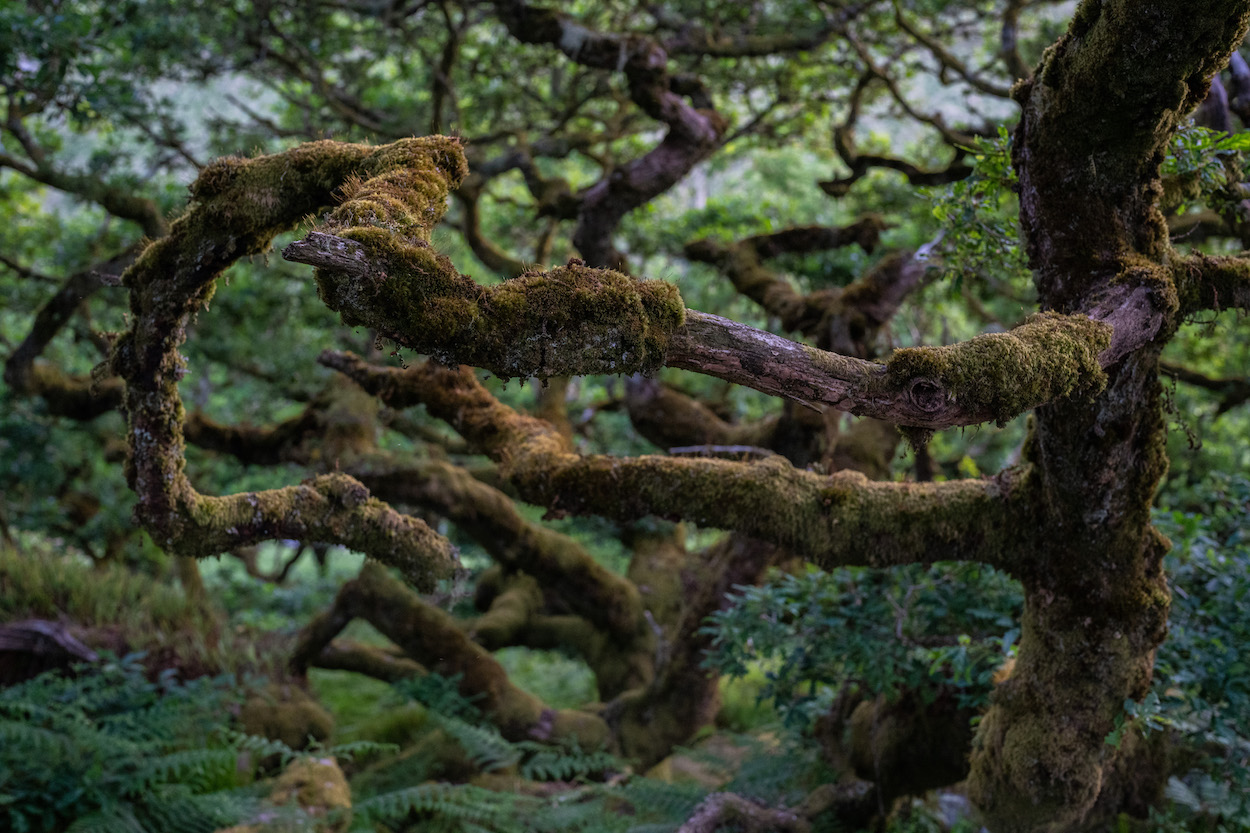Wistman’s Wood is one of the UK’s last remaining temperate rainforests. It came within Prince William’s purview after he inherited the Duchy of Cornwall, the largest privately owned portion of Dartmoor National Park. He has since visited the site, a seven-acre strip of oak woodland on the eastern slopes of the West Dart Valley, posing for photos in a waxed jacket and tweed cap.
Wistman’s is a unique habitat. It has a number of rare mosses and lichens which attach themselves to and around its stunted, gnarly oaks and the large boulders dotted among them. But it is as much its place in folklore as natural history that makes Wistman’s so important.
The extent of the lichens is unlike anything I’ve seen before: the branches look as though they are wrapped in strands of wool
The woods have long been associated with druids. Two centuries ago, a local writer and amateur historian Eliza Bray claimed that ancient Celtic rites and human sacrifices had taken place in the wood. Bray knew a thing or two about death herself: she was widowed in 1821 when her artist husband fell off a ladder into the graveyard of St Andrew’s church in Bere Ferrers, just a few miles south of the woods. Her thesis was that Wistman’s had been left undisturbed while trees were felled all around it – leaving it surrounded by windswept moorland – because it was a pre-Christian holy place.
‘The ascent to Wistman’s Wood is strewn all over with immense masses of granite, that lie scattered in every direction,’ she wrote. ‘In the midst of these gigantic blocks, growing among them, or starting, as it were, from their interstices, arises wildly, and here and there widely scattered, a grove of dwarf oak trees. Their situation, exposed to the bleak winds, which rush past the side of the declivity on which they grow, and through the valley of the Dart at their base, (a valley that acts like a tunnel to assist the fury of the gust) the diminutive height of the trees, their singular and antiquated appearance, all combine to raise feelings of mingled curiosity and wonder… We are all disposed to think that they are really no other than the last remnant of a druid grove.’
Equally, it may simply have been that the amount of boulder scree meant clearing the forest was a lot of work for little gain so no one ever got around to it. But the wood does have an undeniably strange atmosphere that emanates from those oddly diminutive oaks – unlike the mighty oaks of the English imagination, the average height of the trees here is just around 20 feet. The way they grow among forbidding stones, their twisted, mossy branches, and the silence, punctuated by gusts of wailing wind, make an association with the arcane past feel credible: you can see why Bray made this mental leap to the druids.
As well as the druids, there are other folk associations, usually of the satanic or ghostly variety. Some tales linked to Wistman’s evoke not just the Devil but his hellhounds too – which may have influenced Conan-Doyle in the Dartmoor setting and canine motif of his most famous Sherlock Holmes outing, The Hound of the Baskervilles.
I had my own unsettling experience around Wistman’s earlier this year. We were staying in a small cottage in Meavy, about ten miles southwest of Wistman’s, in the first week of March. We’d been for a good lunch at The Cornish Arms in Tavistock then wended home via stops to see various Neolithic monuments, culminating in perhaps the best known in the area, a stone circle called Scorhill set in a remote open moorland under huge skies.
It was a windy, rainy afternoon and we didn’t see another soul, only sheep and wild ponies, until we got to the stones themselves. There we found a lone man carrying out archaeological survey work with tapes and sonar devices. We exchanged a bit of chat. I remarked that his presence and attire reminded me of Enys Men, the folk horror film we had seen a few weeks earlier set in the 1970s in neighbouring Cornwall, and predicated around a scientist at work in a strange landscape, just as he was here.
From there we headed towards Wistman’s. We arrived in the car park just as the only other vehicle was leaving, then set off on the 30-minute walk to the woods. But as we got nearer and the woods came into sight, it became clear that the night was coming on faster than we were going – and that, if we pressed on, it would mean we would be necessarily returning in complete darkness on the uneven rocky ground.
We reluctantly accepted that it would be reckless to continue – and turned back. As we did so, a brilliant full moon rose over the hills that loomed to the east. It was an eerie moment. We didn’t get an accompanying wolf howl, though the wind was making a good impression of one. So we made jokes of the ‘don’t leave the path’ variety as we picked up our pace to get back for a quick drink and warm up by the open fire at the Two Bridges Hotel at the end of the track.
When we eventually got back to our cottage, I went to put some music on while cooking dinner. I had recently discovered a jazz musician, John Surman, with a kind of hippie Seventies post-bop sound, the sort of thing I think of as ‘prog jazz’, that I felt would suit the mood. I searched for Surman on Spotify, chose an album of his at random, one I hadn’t opened before, and put it on. The sound of electronic doodling and baritone saxophone filled the room as I was chopping onions. It evoked exactly the mood I’d been in since our aborted walk to the woods.
It was a windy, rainy afternoon and we didn’t see another soul, only sheep and wild ponies
I glanced at my phone. The first track on the album, the one playing, was called… Wistman’s Wood. Well to be entirely accurate, it was spelled with an extra H, so it was Whistman’s Wood. But still, the coincidence was so extraordinary that I felt a little shaken. For some reason, I had until then assumed Surman was American. But when I then Googled him I found he was from Tavistock – where we had had lunch. It was only then that I properly registered the album’s title, Saltash Bells, taken from the town in Cornwall, where it borders Devon.
We got up early the next morning and went back to Wistman’s just as daylight dawned. Again we were alone. It is quite an extraordinary place with a decidedly odd feel about it. The extent of the lichens is unlike anything I’ve seen before: the branches look as though they are wrapped in strands of wool. And, exactly as Bray described, and Surman in his sax playing seemed to be trying to articulate, it acts as a tunnel for the wind.
Wistman’s has been a site of special scientific interest since 1964 – and concerns about protecting its ancient habitat was one of the reasons Dartmoor was later selected as a special area of conservation. The royal estate will be working with Natural England to restore Wistman’s, allowing it to ‘regenerate naturally’ by reducing both grazing and human foot traffic within the wood itself. They will plant new trees with seed collected from the ancient wood in an attempt to increase the area covered sensitively. One can only hope they retain its atmosphere.







Comments